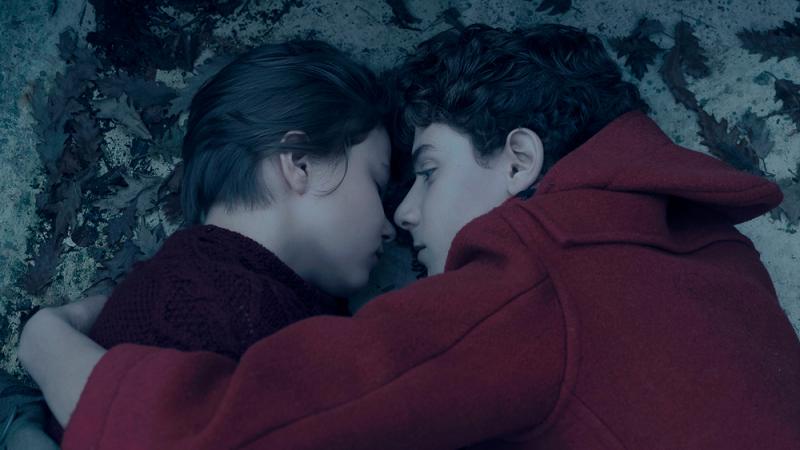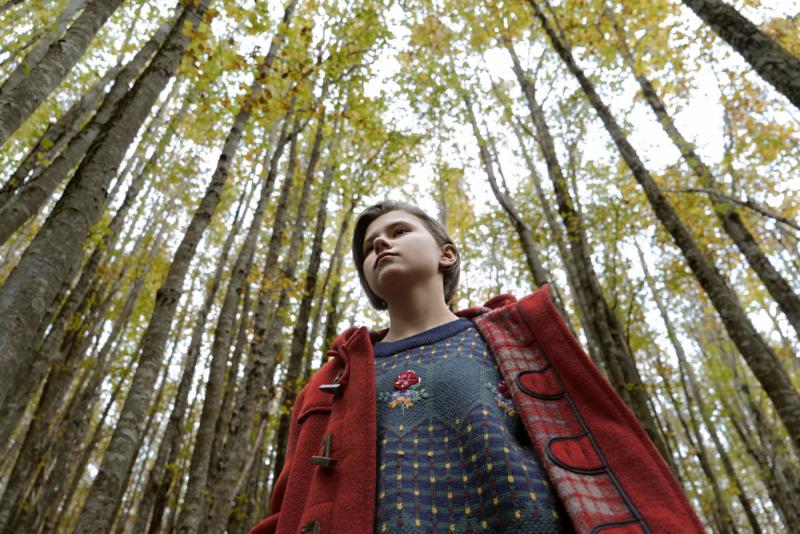A Sicilian Ghost Story review - a beautiful, confusing journey | reviews, news & interviews
A Sicilian Ghost Story review - a beautiful, confusing journey
A Sicilian Ghost Story review - a beautiful, confusing journey
Young love and loss explored in this surreal yet grounded Italian indie

Childhood is an inimitable experience – the laws of the world are less certain, imagination and reality meld together, and no event feels fixed. A Sicilian Ghost Story recreates this sensation in the context of real world trauma, producing a unique and sometimes unsettling cinematic experience.
Luna (Julia Jedlikowska, pictured below) is a rather typical 12-year-old girl: precocious, imaginative, and very much infatuated with her classmate Giuseppe. Although they don’t have the same interests, they share something deeper, a comfort and belonging in each other’s company. On the walk home from school, the two dance around their attraction, Luna carrying a love letter for Giuseppe but denying it’s really for him. They’re chased by a dog, share a scooter ride, and he demonstrates his show horse; it’s a perfect day that ends in a kiss. Then, as if by magic, Giuseppe is gone.
Days and weeks pass, and no-one but Luna seems to care that Giuseppe’s not in school. At his house, no-one answers the door; his stone-faced mother stares hauntingly from the window. The adults of the village refuse to answer Luna’s questioning. Always prone to daydreaming, her imagination starts to run wild as she follows his ghost through the puzzle-like woods and deep lakes. Sicilian Ghost Story is dedicated to Giuseppe Di Matteo, an 11-year-old boy kidnapped by the Mafia after his father turned informant. Rather than a straight adaptation of this tragic story, writer/directors Fabio Grassadonia and Antonio Piazza bring a dark, fairytale quality to the film. Luna’s imagination becomes both her guide and her sanctuary as she tries to come to terms with the grim reality, hinting at a deeper, supernatural connection between the two.
Sicilian Ghost Story is dedicated to Giuseppe Di Matteo, an 11-year-old boy kidnapped by the Mafia after his father turned informant. Rather than a straight adaptation of this tragic story, writer/directors Fabio Grassadonia and Antonio Piazza bring a dark, fairytale quality to the film. Luna’s imagination becomes both her guide and her sanctuary as she tries to come to terms with the grim reality, hinting at a deeper, supernatural connection between the two.
It’s an unusual watch: memories are revisited with different outcomes, dream sequences are often presented as reality, and the internal logic is stretched to breaking point. It is, really, how we remember our childhood – we can recollect the feelings, but not always separate the fact from fiction. This makes for a film that is a pleasure to experience but sometimes frustrating to follow.
The cinematography and sound design create a woozy, hallucinogenic experience
It bares a passing resemblance to recent British indie release Pin Cushion. Both have a young female lead inclined to fantasy, but where Pin Cushion is quirky, Sicilian Ghost Story is something more elemental. The characters are at once dwarfed by and connected with the spectacular landscapes of Sicily. Animals are a constant, and countryside literally hisses and rattles around the humans. It’s at times pagan-like: there’s a deeper spiritual connection with nature that lasts longer than the temporary, evil actions of man.
Visually, the film is stunning. The cinematography and sound design create a woozy, hallucinogenic experience. A variety of wide lenses and low angles add a surrealness to Luna’s journey, drawing a clear line between her world and the standard shots deployed for adults. As the camera focuses on her determined vulnerability, there’s an element of Millie Bobby Brown in Julia Jedlikowska’s performance, only emphasised when her head is shaven. It is a complicated and heavy film to lead, and she does so with ease.
While Sicilian Ghost Story offers some interesting narrative devices, powerful visuals and strong performances, it’s too tonally confused to be considered a complete success. It creaks when toeing the line between fantasy and reality, never quite committing to either to the detriment of both. At times, it feels like Pan’s Labyrinth without the visual effects, or Twin Peaks without embracing the surreal – tons of potential, almost realised.
Overleaf: watch the trailer for Sicilian Ghost Story
Childhood is an inimitable experience – the laws of the world are less certain, imagination and reality meld together, and no event feels fixed. A Sicilian Ghost Story recreates this sensation in the context of real world trauma, producing a unique and sometimes unsettling cinematic experience.
Luna (Julia Jedlikowska, pictured below) is a rather typical 12-year-old girl: precocious, imaginative, and very much infatuated with her classmate Giuseppe. Although they don’t have the same interests, they share something deeper, a comfort and belonging in each other’s company. On the walk home from school, the two dance around their attraction, Luna carrying a love letter for Giuseppe but denying it’s really for him. They’re chased by a dog, share a scooter ride, and he demonstrates his show horse; it’s a perfect day that ends in a kiss. Then, as if by magic, Giuseppe is gone.
Days and weeks pass, and no-one but Luna seems to care that Giuseppe’s not in school. At his house, no-one answers the door; his stone-faced mother stares hauntingly from the window. The adults of the village refuse to answer Luna’s questioning. Always prone to daydreaming, her imagination starts to run wild as she follows his ghost through the puzzle-like woods and deep lakes. Sicilian Ghost Story is dedicated to Giuseppe Di Matteo, an 11-year-old boy kidnapped by the Mafia after his father turned informant. Rather than a straight adaptation of this tragic story, writer/directors Fabio Grassadonia and Antonio Piazza bring a dark, fairytale quality to the film. Luna’s imagination becomes both her guide and her sanctuary as she tries to come to terms with the grim reality, hinting at a deeper, supernatural connection between the two.
Sicilian Ghost Story is dedicated to Giuseppe Di Matteo, an 11-year-old boy kidnapped by the Mafia after his father turned informant. Rather than a straight adaptation of this tragic story, writer/directors Fabio Grassadonia and Antonio Piazza bring a dark, fairytale quality to the film. Luna’s imagination becomes both her guide and her sanctuary as she tries to come to terms with the grim reality, hinting at a deeper, supernatural connection between the two.
It’s an unusual watch: memories are revisited with different outcomes, dream sequences are often presented as reality, and the internal logic is stretched to breaking point. It is, really, how we remember our childhood – we can recollect the feelings, but not always separate the fact from fiction. This makes for a film that is a pleasure to experience but sometimes frustrating to follow.
The cinematography and sound design create a woozy, hallucinogenic experience
It bares a passing resemblance to recent British indie release Pin Cushion. Both have a young female lead inclined to fantasy, but where Pin Cushion is quirky, Sicilian Ghost Story is something more elemental. The characters are at once dwarfed by and connected with the spectacular landscapes of Sicily. Animals are a constant, and countryside literally hisses and rattles around the humans. It’s at times pagan-like: there’s a deeper spiritual connection with nature that lasts longer than the temporary, evil actions of man.
Visually, the film is stunning. The cinematography and sound design create a woozy, hallucinogenic experience. A variety of wide lenses and low angles add a surrealness to Luna’s journey, drawing a clear line between her world and the standard shots deployed for adults. As the camera focuses on her determined vulnerability, there’s an element of Millie Bobby Brown in Julia Jedlikowska’s performance, only emphasised when her head is shaven. It is a complicated and heavy film to lead, and she does so with ease.
While Sicilian Ghost Story offers some interesting narrative devices, powerful visuals and strong performances, it’s too tonally confused to be considered a complete success. It creaks when toeing the line between fantasy and reality, never quite committing to either to the detriment of both. At times, it feels like Pan’s Labyrinth without the visual effects, or Twin Peaks without embracing the surreal – tons of potential, almost realised.
Overleaf: watch the trailer for Sicilian Ghost Story
rating
Explore topics
Share this article
The future of Arts Journalism
You can stop theartsdesk.com closing!
We urgently need financing to survive. Our fundraising drive has thus far raised £49,000 but we need to reach £100,000 or we will be forced to close. Please contribute here: https://gofund.me/c3f6033d
And if you can forward this information to anyone who might assist, we’d be grateful.

Subscribe to theartsdesk.com
Thank you for continuing to read our work on theartsdesk.com. For unlimited access to every article in its entirety, including our archive of more than 15,000 pieces, we're asking for £5 per month or £40 per year. We feel it's a very good deal, and hope you do too.
To take a subscription now simply click here.
And if you're looking for that extra gift for a friend or family member, why not treat them to a theartsdesk.com gift subscription?
more Film
 Urchin review - superb homeless drama
Frank Dillane gives a star-making turn in Harris Dickinson’s impressive directorial debut
Urchin review - superb homeless drama
Frank Dillane gives a star-making turn in Harris Dickinson’s impressive directorial debut
 Mr Blake at Your Service review - John Malkovich in unlikely role as an English butler
Weird comedy directed by novelist Gilles Legardinier
Mr Blake at Your Service review - John Malkovich in unlikely role as an English butler
Weird comedy directed by novelist Gilles Legardinier
 Don't Let's Go to the Dogs Tonight review - vivid adaptation of a memoir about a Rhodesian childhood
Embeth Davidtz delivers an impressive directing debut and an exceptional child star
Don't Let's Go to the Dogs Tonight review - vivid adaptation of a memoir about a Rhodesian childhood
Embeth Davidtz delivers an impressive directing debut and an exceptional child star
 One Battle After Another review - Paul Thomas Anderson satirises America's culture wars
Leonardo DiCaprio, Teyana Taylor, and Sean Penn star in a rollercoasting political thriller
One Battle After Another review - Paul Thomas Anderson satirises America's culture wars
Leonardo DiCaprio, Teyana Taylor, and Sean Penn star in a rollercoasting political thriller
 Steve review - educator in crisis
Cillian Murphy excels as a troubled headmaster working with delinquent boys
Steve review - educator in crisis
Cillian Murphy excels as a troubled headmaster working with delinquent boys
 Can I get a Witness? review - time to die before you get old
Ann Marie Fleming directs Sandra Oh in dystopian fantasy that fails to ignite
Can I get a Witness? review - time to die before you get old
Ann Marie Fleming directs Sandra Oh in dystopian fantasy that fails to ignite
 Happyend review - the kids are never alright
In this futuristic blackboard jungle everything is a bit too manicured
Happyend review - the kids are never alright
In this futuristic blackboard jungle everything is a bit too manicured
 Robert Redford (1936-2025)
The star was more admired within the screen trade than by the critics
Robert Redford (1936-2025)
The star was more admired within the screen trade than by the critics
 Blu-ray: The Sons of Great Bear
DEFA's first 'Red Western': a revisionist take on colonial expansion
Blu-ray: The Sons of Great Bear
DEFA's first 'Red Western': a revisionist take on colonial expansion
 Spinal Tap II: The End Continues review - comedy rock band fails to revive past glories
Belated satirical sequel runs out of gas
Spinal Tap II: The End Continues review - comedy rock band fails to revive past glories
Belated satirical sequel runs out of gas

Add comment